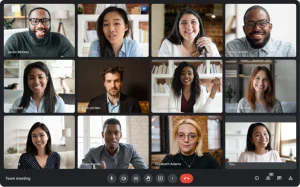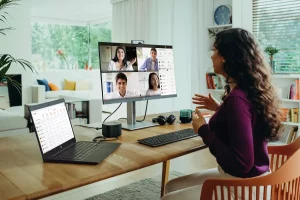Introduction
In today’s world, where digital distance learning is becoming the norm, hosting virtual talent shows has emerged as an innovative way to boost engagement, foster creativity, and build a sense of community among students. This article explores the concept of virtual Talent Show Digital Learning in the context of digital learning, highlighting their benefits, challenges, and how they compare to traditional talent shows.
What is a Virtual Talent Show?

A virtual Talent Show Digital Learning is an online event where participants showcase their talents, such as singing, dancing, acting, or other skills, through digital platforms. These shows are hosted on video conferencing tools like Zoom, Google Meet, or specialized platforms. They allow students to participate from the comfort of their homes, making them a great fit for distance learning environments.
Rise of Virtual Talent Shows
The rise of virtual talent shows started as a creative way to connect during online learning. With the shift to digital classrooms, schools and educators began exploring ways to make learning more fun. Virtual talent shows became a hit because they allowed students to share their skills from home. This new format opened doors for many who might not have joined traditional events.
Benefits of Virtual Talent Shows in Digital Learning

Virtual Talent Show Digital Learning bring many benefits to students and teachers. They help students feel more confident by showing off their unique skills. These shows are also easy to join, so more students can take part. Plus, students get a chance to use technology, improving their digital skills. Virtual shows also make it easy to invite families and friends to watch from anywhere.
1. Encourages Student Engagement
Virtual talent shows break the monotony of online classes and encourage students to participate in fun and creative activities. They help students develop confidence and build social connections despite the physical distance.
2. Boosts Creativity
Students get an opportunity to express themselves uniquely, enhancing their creative thinking skills. From creating video performances to editing and presentation, participants learn new skills valuable in the digital age.
3. Inclusivity and Accessibility
Unlike traditional talent shows, virtual platforms enable wider participation. Students who might be shy or unable to attend in person can join and showcase their talents comfortably from home.
4. Promotes Technological Skills
Hosting and participating in a virtual talent show teaches students how to use technology effectively. It also provides a platform for learning digital tools such as video editing software, presentation apps, and online collaboration tools.
Why Virtual Talent Shows Are Ideal for Digital Learning

1. Engaging Students Creatively
Virtual talent shows encourage students to think outside the box, tapping into their creativity. This not only helps them explore their talents but also builds confidence. These activities integrate seamlessly with digital learning tools, making them a fun addition to traditional academic routines.
2. Fostering Inclusivity and Collaboration
Digital platforms allow participation from students of all backgrounds, ensuring inclusivity. Participants can collaborate using online tools, share ideas, and work together to make the event a success. This builds teamwork and improves communication skills.
3. Enhancing Technological Skills
Students develop technical competencies while preparing for a virtual talent show. From recording performances to editing videos and mastering live-streaming platforms, they acquire practical skills that are crucial in today’s digital age.
How to Host a Successful Virtual Talent Show

- Choose the Right Platform
Select a platform that suits your needs, offers screen-sharing options, and ensures privacy and security. - Plan Well in Advance
Create a clear schedule and communicate guidelines to participants and judges. Share tips for creating high-quality submissions. - Add Interactive Elements
Incorporate live polls, Q&A sessions, or audience votes to make the event more engaging. - Test Technology Ahead of Time
Conduct rehearsals to identify and fix technical glitches before the main event.
Steps to Organize a Virtual Talent Show

1. Plan and Announce
- Select a date and time suitable for participants across time zones.
- Announce the event through digital platforms such as email, school websites, and social media.
2. Choose the Right Platform
Opt for user-friendly and secure platforms like Zoom, Microsoft Teams, or Google Meet to host the event.
3. Set Clear Guidelines
Provide detailed instructions on submission formats, duration, and criteria to ensure smooth participation.
4. Encourage Diverse Participation
Welcome a wide range of talents, from singing and dancing to storytelling and coding demonstrations.
Expanding Access to All Students

One of the greatest advantages of virtual talent shows is that they make it easier for all students to participate, regardless of their location or physical ability. In traditional talent shows, students who are shy or have physical challenges may feel left out or unable to perform. However, with virtual talent shows, students can participate from the comfort of their homes, allowing them to feel more at ease. This increased accessibility helps encourage a wider range of talent and gives everyone a chance to shine.
Encouraging Self-Expression and Confidence
Virtual talent shows are a great way for students to express themselves and build confidence. Performing in front of others, even virtually, helps students develop a sense of accomplishment and self-worth. It allows them to showcase their unique talents, whether it’s singing, dancing, or playing an instrument. By taking part in these events, students gain the courage to step outside their comfort zones, improving both their personal and academic growth.
Promoting Teamwork and Collaboration

Even though virtual talent shows take place online, they can still promote teamwork and collaboration. For group performances, students work together to plan their acts, practice, and rehearse. They also learn how to communicate effectively with each other through digital tools. This process fosters a sense of unity and cooperation, which is essential in both academic and social settings. Group performances help students realize the importance of supporting each other to achieve a common goal.
Learning to Manage Time

Participating in a virtual talent show teaches students how to manage their time effectively. They need to plan, practice, and prepare their acts within a set deadline. These time management skills are valuable for schoolwork and other responsibilities. By balancing their studies and performance preparation, students learn how to prioritize tasks and stay organized.
Challenges of Virtual Talent Shows
Hosting a virtual Talent Show Digital Learning is not without challenges. Poor internet connections can cause problems for students and organizers. Some students may feel less excited because they miss the fun of a live audience. Teachers and schools also need to find the right tools and prepare carefully to avoid technical issues.
1. Technical Issues
Poor internet connectivity and unfamiliarity with technology can hinder smooth participation. These issues need careful planning and troubleshooting.
2. Lack of Physical Interaction
While virtual events are convenient, they lack the energy and enthusiasm of in-person gatherings. Organizers must find creative ways to make online shows engaging.
3. Time Zone Differences
For institutions with students across various regions, scheduling can be a challenge. Proper coordination is essential to ensure inclusivity.
Future of Virtual Talent Shows

The future of virtual talent shows looks bright. As online learning continues to grow, these shows can become a regular part of school activities. With better technology, virtual shows can include interactive features like audience voting or live chats. They also have the potential to include students from around the world, making them even more exciting and diverse.
Analysis Table: Virtual Talent Shows vs. Traditional Talent Shows
| Aspect | Virtual Talent Shows | Traditional Talent Shows |
|---|---|---|
| Accessibility | Accessible to students globally with an internet connection. | Limited to those physically present at the venue. |
| Cost | Low-cost or free platforms for hosting. | Requires venue, decorations, and on-site resources. |
| Inclusivity | Open to a diverse range of participants. | Participation limited by location and availability. |
| Skill Development | Focus on technical and digital skills. | Emphasis on stage presence and physical interaction. |
| Flexibility | Participants can pre-record performances. | Requires live performances at a set time. |
Comparative Table: Benefits and Challenges
| Category | Benefits | Challenges |
|---|---|---|
| Engagement | Increases interaction and creativity | Lack of live energy |
| Technology | Promotes digital literacy | Risk of technical glitches |
| Inclusivity | Welcomes shy or remote participants | Time zone coordination |
| Cost Efficiency | Saves money on physical venues | Requires investment in software/platforms |
Conclusion
Virtual talent shows are an excellent addition to digital distance learning, offering students a creative outlet and fostering engagement. While they come with their unique set of challenges, the benefits far outweigh the drawbacks. By leveraging technology and planning effectively, educators can create memorable and inclusive events that resonate with participants and audiences alike.




